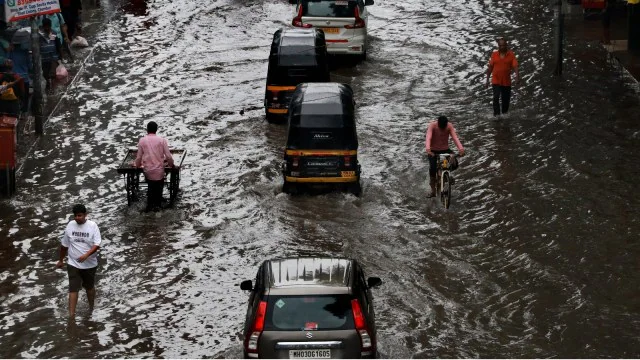Heavy rains caused waterlogging and disrupted suburban train services in some low-lying areas of Mumbai. The NDRF (National Disaster Response Force) has deployed teams to prevent a flood-like situation.
Mumbai rains – The Stark Inequalities
The city’s stark inequalities become most apparent during the rains. The difference in attitudes towards the monsoon—whether one loves or hates it—depends largely on where they live.
From the higher floors, they applaud the 360-degree spectacle of darkened skies, the dance of lightning, the roll of thunder, and the dramatic climax of the skyline obscured by ominous clouds.
Mumbai rains – 2024
The relentless rains have left thousands stranded, destroyed homes, disrupted trains, and impacted businesses, plunging the city into the recurring nightmare of chaos, breakdown, and despair during the monsoon deluge.
Heavy rains lashed Mumbai and nearby areas, severely disrupting the Central Railway’s suburban services due to track waterlogging and causing 50 flight cancellations on July 8. The downpour inundated many low-lying areas, affecting vehicle movement and forcing people to wade through flooded streets. The State Government declared a holiday for all schools in Mumbai, Ratnagiri, and Sindhudurg districts.
The IMD forecasted moderate rainfall in the city and suburbs, with heavy showers in isolated areas over the next 24 hours. The civic body urged citizens to ignore rumors and contact its control room for emergency assistance. Municipal Commissioner Bhushan Gagrani monitored the situation from the disaster management control room.
A forest official reported that over 30 animals, birds, and reptiles were rescued in Mumbai and surrounding districts due to heavy rains. Additionally, there were reports of lost and abandoned pets, strays, domestic animals, and wildlife distress calls from the city and suburbs, according to Santosh Bhagane from the Mumbai range rescue team of the forest department.
Mumbai Rains and Powai Lake Overflow
Mumbai’s Powai Lake started overflowing after being hit by heavy rains over the past few days, a civic official reported. The lake, with a storage capacity of 545 crore liters, began overflowing at 4:45 p.m., according to the official. The water from the lake, however, is not potable and is used only for industrial purposes. When full, the lake covers a water area of approximately 2.23 square kilometers and has a catchment area of 6.61 square kilometers. Located about 27 kilometers from the BMC headquarters, Powai Lake was constructed in 1890 at a cost of ₹12.59 lakh. Seven reservoirs, namely Bhatsa, Upper Vaitarna, Middle Vaitarna, Tansa, Modak Sagar, Vihar, and Tulsi, supply 385 crore litres of potable water to the city.




